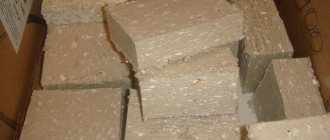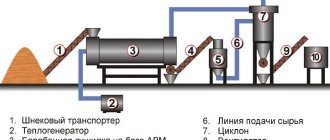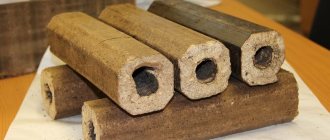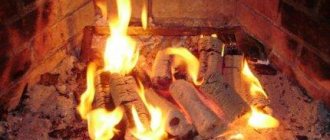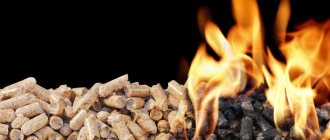Firewood or coal are not available fuels everywhere, but waste from the wood processing industry or agriculture can be found, perhaps, everywhere. It has long been noted that they burn, perhaps a little worse, but they can be used for heating. Just adding sawdust or straw is very inconvenient. Therefore, they came up with the idea of processing them and pressing them into briquettes or pellets. There are even special boilers for fuel granules - pellets. If the fuel is good, they are serviced (the ash is removed) once a month. The best news is that it is quite possible to make pellets with your own hands. This will require quite a lot of equipment, but the basis is a granulator (extruder or pelletizer). There is no way without him.
Advantages of a self-made granulator
Hand-made production of this device allows you to:
- make the device mobile (by attaching wheels to its base);
- make a granulator depending on your requirements, taking into account the number of livestock kept and the amount of feed they need;
- significantly save financial resources, taking into account the cost of purchasing a factory unit and the cost of purchasing any parts not available at home for home-made assembly;
- get the opportunity to independently manufacture a small-sized device, which will contribute to significant space savings in the room where the granulator will be located;
- get the opportunity to increase or decrease the productivity of the granulator, depending on the needs of your own livestock farm;
- get the opportunity to use the granulator not only for its intended purpose, but also as a machine for the production of wood fuel;
- Even a meat grinder can be converted into a granulator.
Feed granulator is a very convenient device
Product storage conditions
Packaged herbal flour is ready for sale and use. To ensure that the product does not lose its nutritional properties, it is necessary to comply with storage conditions and use the feed within a short time. For example, after just six months, the granules will lose half of the carotene (there will be no significant changes in the first 5 months).
It is recommended to store granules in a dry and dark room with humidity below 70%. A hay barn or any storage space will do.
Herbal granules are easy to store and transport, and can also be given to animals as food.
How to make a granulator for feed and grass from a meat grinder with your own hands
The algorithm for making a granulator from a meat grinder from LPH Rabbit is quite simple. If you have certain skills in handling a lathe, grinder and welding, you can make a unit quickly and without difficulty:
- At the first stage, you need to disassemble the meat grinder and rid it of unnecessary parts. The rotation handle, lid and grill are not needed; they can be removed and set aside. If the meat grinder has legs, holes are immediately made in them using a drilling machine to attach the unit to the workbench.
- Internal ribs in the meat grinder body can interfere with the installation of the matrix; they are usually ground off. A new cover is then made from an iron blank to hold the perforated disc at the outlet. To twist, a 6 mm thick wire is welded onto the part or grooves are cut using a grinder.
- On a lathe, a matrix is turned from a metal blank, the size of which is suitable for the neck of the meat grinder. The thickness of the blank must be at least 2 cm. Holes for pressing are drilled at an equal distance from each other, with a small cone-shaped narrowing in the lower part from the inside.
- The screw from the meat grinder needs to be improved. On one side, a hole is drilled in it for the screw holding the pellet knife, and on the other, a groove is drilled for attaching the rotating pulley. When assembling the structure, it is necessary to ensure that both the wheel with a belt drive and the matrix fit against the auger as tightly and accurately as possible. There should be no unnecessary gaps between the parts that cause backlash.
- After all the main parts of the granulator have been manufactured, you can begin assembling the unit. A screw is inserted into the body of the meat grinder, the matrix with holes is pressed against it, and then the two parts are connected using a screw with a knife on it. Then put a cover on the outlet hole and screw it tightly to secure all the elements.
- On the opposite side of the meat grinder, a pulley is put on a turned auger with a drilled hole and also secured with a screw. In fact, at this stage, a do-it-yourself granulator can be considered ready. All that remains is to install it on a workbench, connect the meat grinder pulley with a belt to the engine pulley and test run the device into operation.
For the first time, the granulator from the meat grinder is turned on without load at idle speed. It is necessary to check the functionality of the structure and listen for any extraneous creaks, crackling sounds or excess vibration. If the device operates smoothly and with little noise, a test batch of raw materials is poured into the upper part of the meat grinder and the quality of granulation is assessed in practice.
Marketing methods
Buyers will be livestock farms and farms. This product is almost never sold at retail: cows and horses eat up to 4 kilograms a day, so there is only economic sense in large supplies.
The most convenient way of sales is to enter into a wholesale supply agreement. To do this, you need to find potential clients and send them commercial proposals. You can work both for your region and for others. The advantage of herbal flour is its ease of transportation, so delivery of the product even over long distances will not affect its quality.
To increase your competitiveness and attract more customers, create a website or your own online store. The ability to obtain complete information about a product online, as well as place an order for the required number of kilograms, will attract many buyers. However, you will have to invest 20-25 thousand rubles in the development of a full-fledged store.
Granulator drawings
Drawings and videos of a granulator from a meat grinder with your own hands show that this is a very simple device. Even beginners can handle its production. It is convenient to use a meat grinder as the basis for the unit precisely because it requires minimal modification. When creating a granulator, you only need to remove unnecessary parts of the device and secure some additional elements.
The advantage of the meat grinder is the presence of a ready-made durable screw mechanism
The dimensions of a homemade granulator are determined in accordance with the dimensions of the meat grinder. The main attention should be paid to the matrix; it should fit tightly and without play into the unit body. During the manufacture of the device, the conformity of all fastened parts to each other is checked. A pulley on one side and a cutting knife on the other must be securely attached to the auger.
The do-it-yourself granulator is compact and suitable for installation on a table in the utility room
Sizing
It is very important to determine the size of the future apparatus before starting to manufacture a granulator from a meat grinder. In total, the following indicators need to be measured:
In total, the following indicators need to be measured:
grid parameters (frequency and cell diameter);
It is best to use standard drawings to make a household feed granulator quickly and without lengthy calculations of the correct dimensions. The drawings were drawn up by professionals, so you don’t have to worry about the success of manufacturing the device.
So, for example, the diameter of the case should be 54 millimeters, and the main dimensions are selected in proportion to the radius of the internal shaft, which is 11-13 millimeters.
What can be granulated
Recipes for granulated food
The following are granulated:
- feed, hay, straw;
- sawdust, coal (in pressed form they are used for heating premises, and when they are granulated, the process of removing waste from lumber is simplified);
- peat, animal manure, bird droppings (used in briquettes as fertilizer);
- chalk, lime;
- polymer shavings (in the free state they are characterized by increased volatility).
Benefits of pellets
Pellets have a number of advantages over other types of heating material:
- Great heat dissipation
- Convenient storage,
- Economical use,
- Fire safety,
- Environmental friendliness,
- Possibility of storage near living quarters,
- Does not cause allergies during combustion and storage,
- Availability,
- Economic benefit: the use of pellets reduces the cost of heating a house and outbuildings several times,
- High thermal conductivity.
In Russia, this type of fuel is just gaining popularity, but in European countries and the USA it is widely used.
Heating pellets are not only more profitable than chips with peat, briquettes or coal, but also much more convenient during transportation, unloading and loading.
DIY granulator from a meat grinder (video)
Creating a granulator at home will allow you to save on purchasing a factory version of the device. You can use environmentally friendly fuel to heat your home without spending anything other than electricity when creating sawdust pellets. Since environmentally friendly fuel and livestock feed are in demand on the market, it is worth thinking about opening your own production. If you are farming, a granulator will help feed your entire livestock, and excess feed can be stored or sold.
Equipment
There are many options for completing pellet production lines: equipment suppliers offer entrepreneurs a choice of both small stand-alone units with a capacity of 50–150 kg/h, and full-fledged mini-factories that produce tens of tons of wood pellets per shift.
The main element of any complex is the granulator: the market offers models with a diesel engine, an electric drive, or driven by a power take-off shaft. The last option is considered the most economical, but it requires the presence of a tractor itself. In addition, the rest of the production equipment requires connection to electrical networks - accordingly, other things being equal, it is more advisable for a novice entrepreneur to refuse to purchase additional equipment and give preference to the second option.
The list of equipment necessary for the production of pellets is not limited to the production line. The entrepreneur will have to additionally buy a forklift for transporting raw materials, a truck for delivering finished products, and also equip the workstations of the director and accountant with office equipment.
Equipping a workshop with a capacity of 500 kg/h
| Name | price, rub. | Qty | Amount, rub. |
| Workshop (RUB 3,001,000) | |||
| Bunker for raw materials | 15000 | 1 | 15000 |
| Chopper | 140000 | 1 | 140000 |
| Screw conveyor | 58000 | 2 | 116000 |
| Drum dryer | 550000 | 1 | 550000 |
| Hammer mill | 132000 | 1 | 132000 |
| Sawdust hopper | 39000 | 1 | 39000 |
| Mixer | 80000 | 1 | 80000 |
| Granulator | 1212000 | 1 | 1212000 |
| Scraper conveyor | 57000 | 2 | 114000 |
| Cooler | 365000 | 1 | 365000 |
| Pellet hopper | 15000 | 1 | 15000 |
| Weighing system | 98000 | 1 | 98000 |
| Pipelines | – | – | 15000 |
| Lighting | 1000 | 10 | 10000 |
| Installation of equipment | – | – | 100000 |
| Office (RUB 65,800) | |||
| Table | 2500 | 2 | 5000 |
| Armchair | 2000 | 2 | 4000 |
| Chair | 1200 | 4 | 4800 |
| Computer | 18000 | 2 | 36000 |
| Telephone set | 1000 | 2 | 2000 |
| MFP | 9000 | 1 | 9000 |
| Lamp | 1000 | 4 | 4000 |
| Router | 1000 | 1 | 1000 |
| Other equipment (RUB 616,000) | |||
| Forklift | 285000 | 1 | 285000 |
| Hydraulic trolley | 9000 | 1 | 9000 |
| Pallets | 120 | 50 | 6000 |
| Raw material moisture meter | 26000 | 1 | 26000 |
| Freight car | 290000 | 1 | 290000 |
| Total: | 3682800 |
Advice from professionals
Gearbox manufacturing
To make a granulator, you can use a homemade gearbox. One of the common manufacturing options: rear axle from heavy Ural or Dnepr motorcycles. The subordinate ratio of this element is 4.62, it is compact, so it can be placed vertically.
You can connect the engine to the gearbox using a cardan or an elastic coupling from the same motorcycles. The drive gear has a splined shank onto which a cardan or elastic coupling can be mounted.
Opening cost and profitability
The cost of opening an enterprise for the production of herbal flour will be at least 2 million rubles. This impressive amount is explained by 2 factors:
- high cost of equipment (manufacturing will require 6-7 expensive devices and machines);
- the need to rent plots of land for the procurement of raw materials.
The enterprise will process 8-10 tons of raw materials daily. At least the power of the equipment will provide such an opportunity. The yield of finished herbal flour is 20%, that is, it is realistic to produce 2 tons of finished product per day.
Let's assume that the enterprise operates 7 days a week in 2 shifts and produces 120 tons of finished product per season (2 months). A kilogram costs an average of 19 rubles, that is, revenue will be 2,280,000 rubles. Not a bad result for two months, however, business is limited by the season and costs need to be calculated.
The profitability of grass meal production is no more than 10%. Opening costs will be recouped only after 2-3 seasons, so it is recommended to combine the business with other areas of activity.
With flat die
Elements
The main elements are:
The body must consist of two components: external and internal. In this case, the diameter must be chosen such that the matrix in the upper part of the structure can rotate freely. There should always be a small gap between the inner and outer housings.
Necessary materials
Manufacturing a feed granulator does not require expensive materials and spare parts.
To make a homemade granulator you will need:
steel or tin sheets;
felt-tip pen or marker.
If possible, it is better to use components made of high-quality or alloy steel.
Step-by-step instruction
First you need to prepare a disk twenty millimeters or more thick. It is important to remember: thickness affects the size of the granules and performance. Therefore, as the thickness increases, you need to choose a more powerful electric motor.
Make a hole in the disk, attach the gears to the shaft and attach it with a coupling perpendicular to the body.
The gearbox should be secured to the bottom of the device using bearings and a coupling. Then weld the ears to both parts of the body, having previously connected them with bolts.
Weld a frame from corners or channels. Install on the granulator itself. Place the rollers and matrix into the device.
Rigidly attach the product to the frame using bolts. Install the electric motor. After this, attach the gearbox to the output part of the rotating shaft.
After final assembly of the device, as a final touch, you need to apply metal paint if the case is not made of stainless steel.
The first start should be carried out only after the paint layer has completely dried.
Industrial technology
The pellet production process can be divided into several stages. First, the preparation and crushing of raw materials is carried out. In industrial conditions, the material is also sorted and, after purification from impurities, enters the pre-crushing line. After this, the raw materials must be dried. For this purpose, aeration or drum drying units are used. The residual moisture content of sawdust should be below 14%.
The next stage in the production of pellet fuel is fine crushing of the material. The use of special equipment allows you to reduce wood chips to the state of flour. The maximum fraction size after this process is 4 mm. Then the moisture content of the material is controlled again and, if necessary, secondary drying is carried out. Otherwise, the raw materials will not be pressed.
At the final stage of production, the crushed dry material enters special pressing plants. It is pressed through a matrix with cone-shaped holes of certain sizes. Thanks to the special shape of the channels, the sawdust is compacted. Also, under pressure, the temperature of the raw material increases and the substance lignin is released. It is contained in any type of wood and promotes strong bonding of the fraction. When leaving the pressing plant, the granules can have a temperature of up to +90°C and must be cooled.
Setting up the granulator
As soon as the preparatory process and grinding in of the granulator matrix are completed, setting the parameters begins. They are influenced by the quality of raw materials and the specified characteristics of the granules. The optimal moisture content of the starting products is from 10 to 12%.
Adjusting the granulator rollers includes setting the gap size. It is important to remember that a small gap will create excess pressure, which will lead to rapid wear of the press rollers, shafts and drive mechanism.
After granulation is completed, the gap must be increased so that when switching on again, the moving components are not damaged. The gap is adjusted before each start to obtain the required pressure for the formation of optimal granule density. Thus, when adjusting the granulator rollers, the gap size should provide the pellets at the outlet with the desired shape and hardness. But most importantly, you need to choose high-quality raw materials and take into account the design features of the unit. So that the question does not arise why the granulator matrix is clogged.
Pellet manufacturing technology
Long-burning solid fuel boilers for home heating
The raw material goes through several stages in the process of preparation and production of the final product:
- Splitting up. The waste grinding procedure makes it possible to obtain a fine-grained composition of granules whose dimensions do not exceed 2x25x25 mm. This is necessary to facilitate drying.
- Drying. There are several ways to carry out this step, it all depends on the type of equipment used in production. The basic rule is that after drying, the moisture content of the raw material should not be more than 10%.
- Additional grinding. A hammer mill is used, which crushes the granules into fractions up to 4 mm in size.
- Enrichment with moisture. The substance is passed through a screw mixer and is saturated with moisture.
- Pressing. Various types of presses are used, through which the mass is passed, comes out of the sieve and is trimmed with a knife - the process is automated, the temperature is maintained within +100 C.
- Cooling and packaging.
Sawdust granules: production stages
A problem when making sawdust pellets at home may be the need for additional equipment. You can build a great DIY pelletizer, but it's important to remember the additional steps involved in pellet production.
When working with a granulator, you must follow safety regulations
Scheme of the stages through which sawdust passes before granulation:
- Coarse crushing. Sawdust and chips can be large and damp, that is, unsuitable for making pellets. Therefore, the first step will be crushing. At the exit, the size of wood waste should not exceed 1.25 centimeters per cube.
- The second stage is drying. Sawdust that was lying, for example, in the open air could be exposed to water. But even if the sawdust was stored in special bunkers, the humidity level for making pellets should not exceed 8-13%.
- The next stage is fine crushing. Typically, hammer type crushers are used. At the output, sawdust sizes do not exceed 1.5 mm and 4 mm for production low-grade pellets.
- Next comes the granulation itself. For better gluing, the sawdust is moistened. For soft wood, water is used, for hard wood, hot steam is used. Rocks with a high resin content bond best.
- The fifth stage is sawdust pressing. At this stage, granulation itself occurs.
- Now the sawdust needs to be cooled, since after the granulation process, due to pressure, its temperature can reach 80 degrees. At this temperature they crumble easily.
- Sawdust that has not been compressed is sifted out and, for convenience, the granules are packaged.
Considering the passage of all these stages, we can conclude that the process of making pellets at home is a rather labor-intensive process. However, when using sawdust that meets the moisture and size standards, only a pellet granulator can be used.
Additional features
If a large amount of wood waste accumulates on your site, you can also put it to good use using a self-made granulator. Accumulated wood chips must first be dried and then passed through a granulator. As a result, you will receive wood pellets, which can be easily and profitably used during the heating season, of course, if you have stove or steam heating installed in your house.
Pellets
Wood pellets take longer to smolder, and therefore emit a significant amount of heat much longer than chopped firewood. Using this type of fuel will help you save significantly on the purchase of coal and firewood.
Pellet burning
Table. Comparison of heating costs
| Room area, sq. m. | 100 | 150 | 200 | 250 | 300 | 350 | 400 | 500 | 700 | 1000 |
| Pellets, t | 4,9 | 7,4 | 10,3 | 12,3 | 14,7 | 17,2 | 19,6 | 24,5 | 34,3 | 49 |
| Electricity, kWh | 172700 | 25906 | 34542 | 43177 | 51800 | 60449 | 690084 | 86355 | 120800 | 172711 |
| Gas, m3 | 2396 | 3594 | 4792 | 5990 | 7189 | 8387 | 9585 | 11980 | 16774 | 23963 |
| Coal, t | 3,3 | 4,9 | 6,6 | 8,2 | 9,9 | 11,5 | 13,1 | 16,4 | 23 | 32,9 |
| Wood, m cubic. | 13,5 | 20,2 | 27 | 33,7 | 40,4 | 47,2 | 53,9 | 67,4 | 94,4 | 134,8 |
Screw press
Description and benefits
This mechanism is used to produce granulated feed from grain and straw pellets, which are used as top dressing. In just one hour of work, it is possible to process 200 kilograms of raw materials into 200 kilograms of finished feed. You can regulate the amount of product by adjusting the power and performance of the equipment.
The principle of operation is as follows: the raw material is fed into the upper part of the apparatus, which moves inside the wheel, is pressed by a screw through holes in the matrix and takes the form of granules.
Advantages of this type of granulators:
- high performance;
- simplicity of design;
- ease of making with your own hands.
If you improve the device and select more wear-resistant components, you can even recycle wood.
Necessary materials
The materials needed are the same as for the manufacture of a granulator with a flat matrix; the differences appear precisely in the matrix itself.
For production you will need:
- screw DIN 478 M5-10;
- shaft;
- bearing DIN 625-6207;
- bearing cover;
- retaining ring DIN 471-35-1.5;
- sleeve;
- video clip.
Large equipment for manufacturing will require: a welding machine, an angle grinder, a drilling machine and a lathe.
Materials:
- motor;
- gearbox;
- bearings – 2 pcs. to the diameter of the mounting hole;
- metal blank for the matrix;
- metal rod 10 mm;
- pipes for the body.
The structure must be steel, so the components must be reliable, durable, but not harder than steel, so that the screw granulator works for a long time.
Drawing up a drawing
To construct a drawing, the most important parameters are the dimensions of the device itself, the diameter of the screw and the type of matrix: with the size and frequency of the cells.
Everyone chooses the dimensions independently, but the most common are:
- gearbox speed – 120-150 rpm;
- cone angle – 70°;
- case diameter – 58 millimeters;
- screw height – 52 millimeters;
- The diameter of the shaft outlet is 30 millimeters.
Most often, the parameters of parts change as productivity increases: the higher it is, the larger the dimensions required. Ball and tapered roller bearings must be used.
Making a screw
This is the most important step in making a screw granulator with your own hands.
Screw manufacturing steps:
- shaft selection;
- making mounting holes for bearings;
- rolling and welding of rod;
- grinder processing.
The larger the thread pitch, the higher the productivity, and the lower the pressure on the die.
Matrix
There is such a pattern: the larger the matrix cross-section, the higher the efficiency. Small holes need to be widened with a drill and be sure to be sanded. The strength of feed pellets depends on their length, which is determined by the thickness of the matrix disk. In this case, you need to take into account: the longer the granules are planned, the thicker they should be, so you need to increase the diameter of the matrix cells and its thickness.
The matrix is made of steel plate grade 45. It is advisable to use alloy or stainless steel. The thinner the matrix, the faster it wears out. The holes in the cells can be drilled and must be sanded.
The diameter is selected depending on the thickness of the matrix disk: a 6 mm mesh is suitable for a 40 mm disk thickness; 4 mm – for 25 mm; 3 mm - for 20 millimeters, respectively.
The durability of the matrix depends on the following factors:
- consistency of raw materials (presence of abrasive components, lack of oils);
- changing the feed rate of the source material;
- corrosion due to aggressive organic compounds - oils, fats, bran.
The power of the matrix depends on the thickness, so the diameter of the cells should be approximately 8-10 times less than the thickness.
Body of two or three sleeves
To make the casing, you will need a pipe equipped with a replaceable sleeve, which must be welded to the edges of the housing. The loading hole is made from a piece of small diameter pipe. The ends are equipped with flanges.
The bushing can be replaced. Its thickness should be six millimeters. It is necessary to leave a mounting socket to attach the matrix to the inside of the case. Five plates must be welded onto the bushing to distribute the load when feeding raw materials.
Device design
Rollers and working matrix
To assemble the mechanism yourself, you need to understand the structure of the granulator. The unit consists of:
- grounds;
- electric motor (power from 15 kW);
- matrices;
- gearbox;
- shaft;
- containers for raw materials and finished products.
The matrix is the main part on which the speed and efficiency of the device depends. It comes in two main types – cylindrical (ring) and flat. The first is a drum with holes and rotating rollers. Under pressure, the raw material passes through the holes and is cut off with special knives at the exit.
The matrix of the second type (flat) consists of a hard disk fixed on the shaft. The principle of its operation is no different from the cylindrical one. Such devices are more modern and suitable for processing solid wood waste, which is not possible for devices with a ring matrix. In terms of operating speed, the second type of mechanism is also the leader.
Working principle of flat die granulator
There is another type of granulator, in which the raw material is pressed through a matrix using a rotating screw, similar to a meat grinder. They are suitable only for processing fine-grained, pre-ground materials, and because of this feature they are rarely used for wood waste.
It is recommended to purchase the matrix ready-made. Factory-made parts are sold as components for branded devices. In addition, their production can be ordered from private craftsmen.

